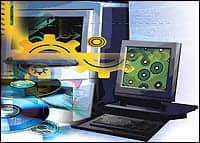Researchers at Polytechnic Institute of New York University (NYU-Poly) , New York, have created an ultra-sensitive biosensor capable of identifying the smallest single virus particles in solution, an advance that may revolutionize early disease detection in a point-of-care setting and shrink test result wait times from weeks to minutes.
Their technique is a major advance in a series of experiments to devise a diagnostic method sensitive enough to detect and size a single virus particle in a doctor’s office or field clinic, without the need for special assay preparations or conditions. Normally, such assessment requires the virus to be measured in the vacuum environment of an electron microscope, which adds time, complexity and considerable cost.
Instead, the researchers were able to detect the smallest RNA virus particle MS2, with a mass of only 6 attograms, by amplifying the sensitivity of a biosensor. Within it, light from a tunable laser is guided down a fiber optic cable, where its intensity is measured by a detector on the far end. A small glass sphere is brought into contact with the fiber, diverting the light’s path and causing it to orbit within the sphere. This change is recorded as a resonant dip in the transmission through the fiber. When a viral particle makes contact with the sphere, it changes the sphere’s properties, resulting in a detectable shift in resonance frequency.
The smaller the particle, the harder it is to record these changes. Viruses such as influenza are fairly large and have been successfully detected with similar sensors in the past. But many viruses such as Polio are far smaller, as are antibody proteins, and these require increased sensitivity.



